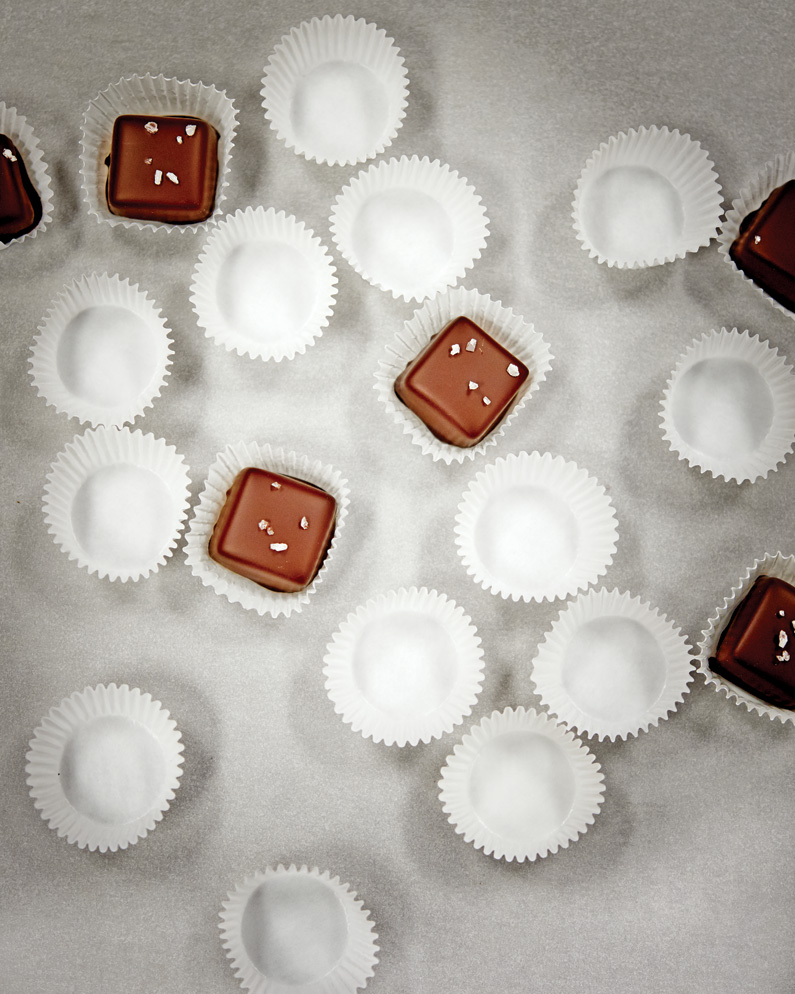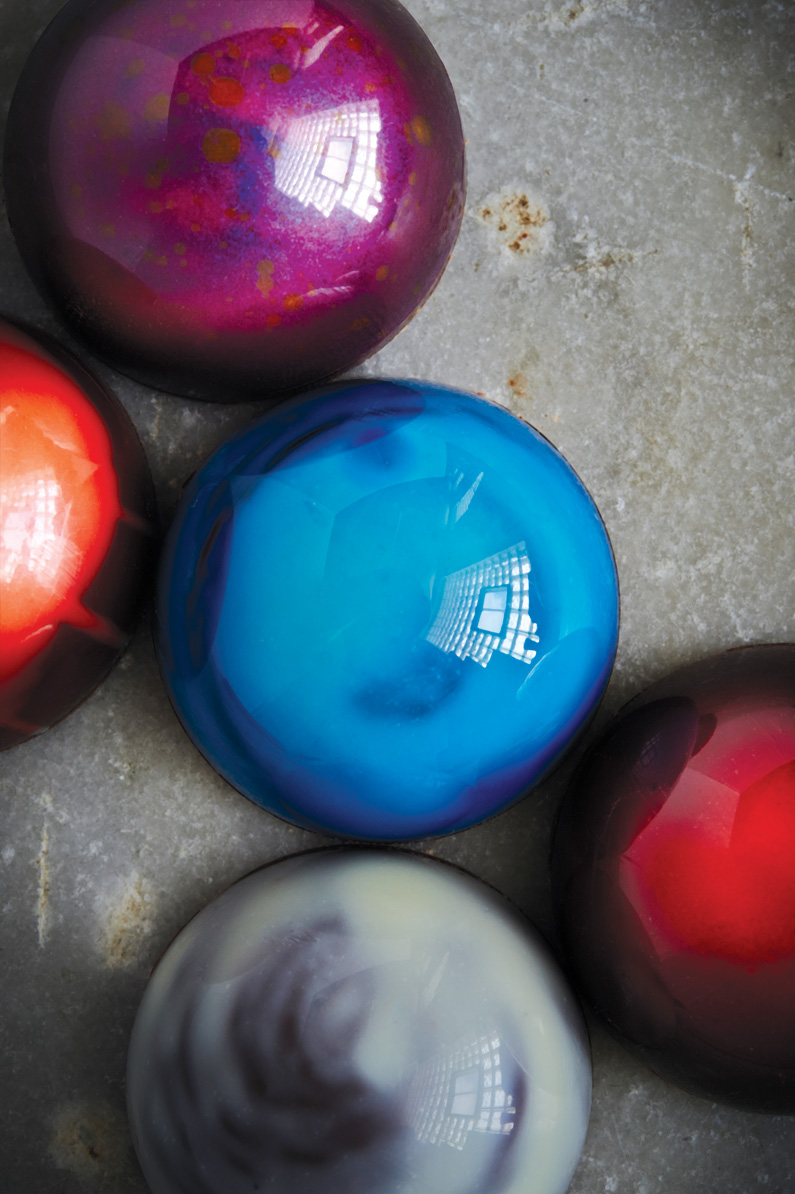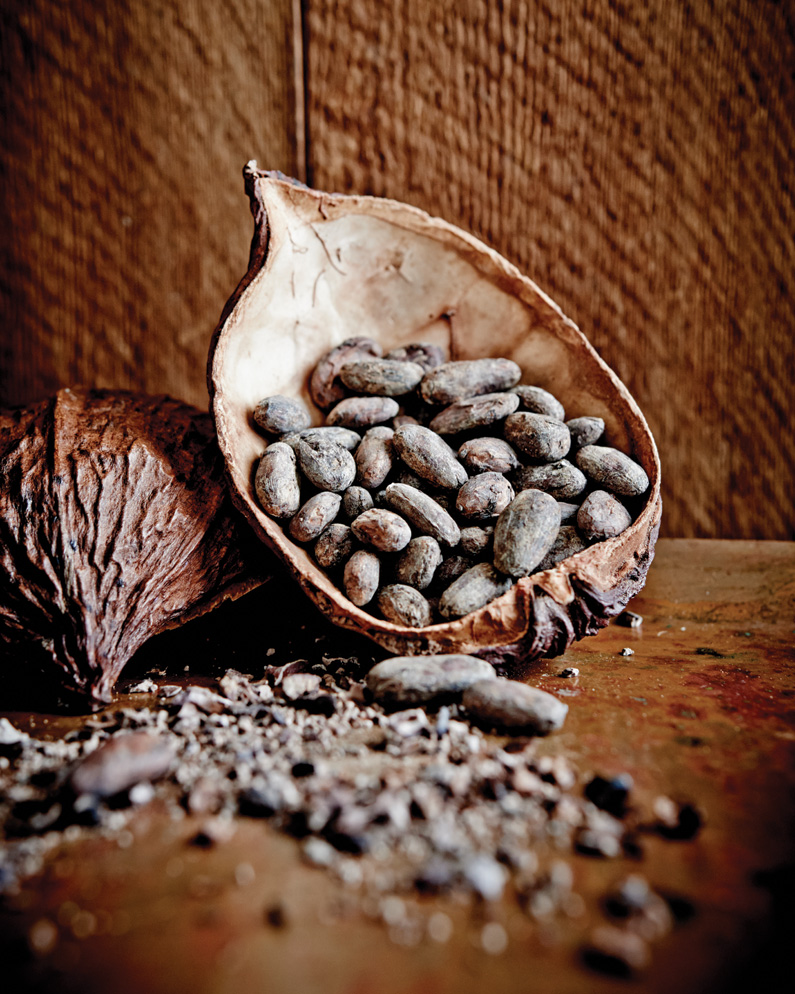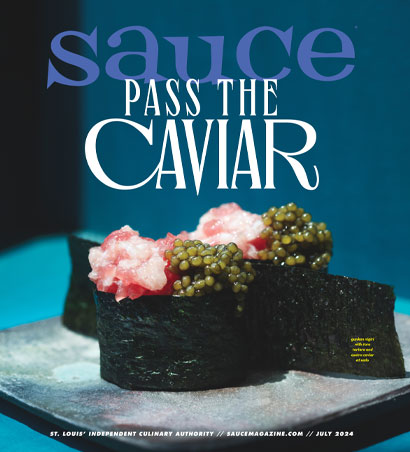How St. Louis Chocolatiers are Raising the bar
It was a Saturday at Kakao Chocolate during the height of the Christmas shopping season. The little bell on the door of the Maplewood shop tinkled incessantly, a sign that yet another person was on the hunt for sweets. Shoppers browsed the retail area, picking up little bags of chocolate bark and ornament-shaped chocolates. They lingered at a display case, torn between truffles and caramels, more often than not indulging in each. Cashiers couldn’t ring up sales fast enough to keep the line less than five deep. Beyond the counter, the scene was just as bustling.
I tried to stay out of the way as five women cooked caramel a gallon at a time, cut each batch with hand-held rollers, dipped pieces in chocolate and sprinkled them with a few coarse grains of sea salt. Yet, despite the urgency of keeping Kakao’s best-selling product – sea salt caramels – on the shelves, they enthusiastically explained why they worked there. “It’s neat that Brian [Pelletier] lets us play,” remarked Jenny Bazzetta, production manager at the shop, about Kakao’s owner. This playfulness starts with ingredients, and the number of locally made foods and beverages making their way into Kakao’s confections reads as long as a farmers market vendor list: Park Avenue Coffee, Stringbean Coffee, Naked Bacon, Grandma’s Nuts, Traveling Tea, The Big O ginger liqueur, and beer from a handful of area breweries. As I eyed sheet pans of Mexican chocolate bark with cinnamon and chile peppers, Bazzetta’s co-workers echoed agreement about their freedom to experiment and the creativity it inspired. They proudly shared how two former Kakao employees had gone on to work at Mast Brothers Chocolate in Brooklyn, N.Y., one of the most progressive bean-to-bar craft chocolate companies in the U.S.
In the industry, bean-to-bar is a bigger deal than you might think. While chocolate manufacturers produce a broad range of chocolate from fermented and dried cocoa beans that they sell wholesale, chocolatiers buy chocolate to melt for use as coating or molding for chocolate confectionary. Bean-to-bar chocolate companies like Mast Brothers do it all, from processing to cooking, which enables them to have more control and a more sustainable production. Although chocolatiers and craft chocolate lovers alike have their fingers firmly pressed to Mast Brothers’ pulse, don’t discount what’s made in Missouri.

SWEET DEVELOPMENTS FROM THE SHOW-ME-STATE
This year, Bissinger’s Handcrafted Chocolatier is moving its headquarters and manufacturing operations from Gratiot Street to a 220,000-square-foot building in North St. Louis city to keep up with the national demand for its chocolates. Another locally based chocolatier growing its national reach is family-owned Chocolate Chocolate Chocolate Co. Founded in 1981, it relocated its operations to a bigger facility on The Hill in 2012. Now, it’s working on another production line to accommodate the demand for its dark chocolate products.
Business is similarly brisk for smaller chocolatiers around town. Pelletier is in negotiations to open a Kakao storefront in the Centene Building in Clayton, which would mark the third location for the company he founded only six years ago. Little Dipper Chocolate owner Beth Prindable may not have a storefront, but since her 2013 sales doubled from the previous year, this Clayton Farmers Market vendor hopes to open a brick-and-mortar shop within the year. The big news – at least for fans of bean-to-bar craft chocolate – comes from Rick Jordan Chocolatier. Owner Rick Jordan will vastly increase the quantity of bean-to-bar chocolates that he makes at his boutique shop in Town & Country when a new winnower designed by Missouri S&T engineering students arrives this month. Having a high-tech winnower will enable Jordan to separate cacao beans from their shells more efficiently. What’s more, if the 40 cacao trees Jordan is growing at his home in West County remain healthy, in two years’ time, he’ll become the first local cocoa grower.
With the rapidly growing local chocolate scene, it should come as no surprise that Retail Confections International is holding its annual convention in the Gateway City this summer. “It’s really cool that, for Missouri, you have these few chocolate makers and a bunch of chocolatiers that are making national and international accolades,” said Jordan, citing bean-to-bar chocolate companies Askinosie in Springfield and Patric in Columbia, as well as chocolatier Christopher Elbow in Kansas City. “The chocolate scene is New York and San Francisco and Vegas, and then this weird little place on the map – Missouri – boom! Just pops up.”

WHEN CREATIVITY CALLS
“Today is an experiment,” said Conor VanBuskirk as he led me past jewelry-esque display cases filled with inventive truffles like raspberry wasabi, blood orange pistachio, pomegranate and rosemary, and candied pear and goat cheese. Downstairs in the kitchen of VB Chocolate Bar, he pulled out three different wines from Cedar Lake Cellars, explaining how the winery in Wright City, Mo., wanted its product used in chocolates that it could offer in its tasting room. VanBuskirk pointed to three order tickets scrawled with notes: truffle recipes in development. Today, we would find out whether his ideas on paper actually worked.
Truffles are essentially balls of ganache – a mix of chocolate, cream, sugar and butter – that also can be used as a filling for chocolates. The original truffle was a round of ganache rolled in chocolate and cocoa powder, named after the black truffle fungus that it resembled. But we had quite a way to go before we could bite into a truffle and hope for melt-in-your-mouth goodness.
First, we had to make the ganache. In one bowl, he mixed together water and sugar. In a separate bowl, he mixed cream, honey and salt. There is no stove in VanBuskirk’s chocolate production area, so we marched upstairs to the cafe where he caramelized the water and sugar over heat, then added the cream mixture and brought it to a boil. Down the stairs we went to repeat the process for truffle batch No. 2, which would feature a dark chocolate ganache with Cedar Lake’s port. Upstairs. Downstairs. Time to mix the ganache for truffle No. 3 that would highlight the flavors of norton and cherries. Soon enough, my thighs were burning. “It’s how I get my exercise,” said the burly VanBuskirk, who listens to sports talk radio while making fine chocolates and considers the baristas at VB to be “so artsy they wouldn’t know it if Michael Jordan walked into the room.”

When the ganache had cooled to 88 degrees, VanBuskirk added butter and wine and then placed the three bowls of ganache in the walk-in cooler to chill further. Next, he sprayed polycarbonate molds with tempered cocoa butter using a spray gun called a pistole. The oval- and circular-shaped shells of the molds were then cast with the chocolates VanBuskirk had selected for the test recipes – one would have 75 percent Tanzanian, the other two would see 55 percent chocolate by Belgian chocolate company Barry Callebaut. Once the chocolate cooled and set, he piped ganache on top.
After 2½ hours of recipe testing, it was time to get the chocolate moving, literally. VanBuskirk relies on a Hilliard coating machine that enables tempered chocolate to continuously stream down a shoot and enrobe whatever is passing through the conveyor belt underneath. For VanBuskirk’s one-man operation, the machine is a huge timesaver, but he still has to be ready to grab the chocolates when they reach the end of the line, lest they fall to the ground. Three hours after we began, the truffles were finished. Each batch held just 125 truffles. That’s small-batch.
From a basement kitchen in Cottleville, Mo., to 21-employee Kakao to tiny businesses like Little Dipper Chocolate and Bittersweet Artisan Truffles that work out of a commercial kitchen and don’t even have a storefront, a love for experimentation is everywhere. “The experiments – that’s what keeps me going,” said Prindable of Little Dipper Chocolate. Developing a winning basil truffle and making smoked chocolates are just two of the many to-dos on a checklist that also includes accounting, purchasing, packaging and selling. “It’s hard because sometimes I give this business more attention than my son. But this is a baby, too,” she said. And how sweet it is when an awesome recipe nets a big account? Such is the case with Bittersweet Artisan Truffles owner Audrey Scherrer, whose decadent micro-batches of salted caramel chocolate sauce now sit on the shelves at newly opened Fields Foods in Lafayette Square.

THERE’S A LOT WRAPPED UP IN A PIECE OF CHOCOLATE
When I began researching this story, I quickly realized I would never cut it in the choco biz. That’s because no matter what funky, new flavor combination these chocolatiers concoct, making chocolates is an exact science. “You have about 2 degrees of forgiveness,” said Jordan on the temperature of tempered chocolate, as well as ambient temperature and humidity. Dan Abel Jr., vice president of operations at Chocolate Chocolate Chocolate Co., offered physical evidence of just how critical temperature is during a tour of the factory. He pointed out an alarm system on the wall that sounds if the temperature of the room changes more than 2 degrees. For Abel, that has meant phone calls from the alarm company and emergency trips to the factory in the dead of night.
Another less-appreciated aspect about chocolate is that, since it comes from cocoa beans, the harvest is different every season. Pelletier likened chocolate to wine. Nuances in cocoa exist on a micro scale – from farm to neighboring farm, not just from country to country. Those distinctions in flavor are exciting for bean-to-bar craft chocolate enthusiasts, but for big chocolatiers like Bissinger’s, they also pose a challenge. One of Dave Owens’ jobs as the company’s chief chocolatier is to ensure product consistency. The chocolate enrobing its soft-centered crèmes, for example, has to taste the same every time. “I have to know the science,” he said. Owens admitted that his job is “not as spontaneous” as his former restaurant life as chef-partner of Cardwell’s at the Plaza and Terrene, but he enjoys the challenge of “making things that are repeatable” and figuring out how to give products a long enough shelf-life through formulation instead of artificial ingredients or preservatives.

The biggest misunderstanding surrounding chocolate is the price tag. “The price of cocoa is now the highest in history,” Abel said. Factor in the cost of materials, labor (It takes four days to make an average batch of candy at Chocolate Chocolate Chocolate Co.) and packaging, and you’re looking at $20 for a 15-piece assorted box of its platinum collection, with profit margin still razor thin – and we’re not even talking single-origin chocolates.
So let’s talk single origin. The $8 you’re paying for a 100-gram bar of chocolate at Rick Jordan Chocolatier is a really fair price. “Making chocolate from scratch – bean-to-bar – is very rare and very expensive to do,” Jordan said. He sources single-origin beans from countries like Ghana, Tanzania, Haiti and Costa Rica, but for him to make a chocolate bar from scratch, the beans first have to be fermented and dried (which happens before they arrive at his shop), then roasted, ground and refined into chocolate. “To do that can be more than $25 a bar,” he said. So, while Jordan currently sells seven types of single-origin bars, he gets more mileage out of certain premium chocolates by using them to make small-sized confections.

THERE ARE GOOD AND BETTER WAYS TO ENJOY CHOCOLATE
What Pelletier dubbed “gas station chocolate” is certainly cheaper than what you’ll pay at a boutique chocolate shop. But what’s really inside that 75-cent package? “There are artificial colors in there that are illegal in Europe but legal here,” said Pelletier. He continued to run down the list of fake ingredients: “Artificial flavorings ... like imitation vanilla. It’s made from wood pulp.”
Aside from real ingredients, there’s a whole other aspect to chocolate that you can’t get from a convenience store. “We see people who come into the store who are excited about chocolate. They can smell it. They see people making it,” said Pelletier. “It’s the whole experience. People have a connection to it.”
The busloads of visitors coming through Chocolate Chocolate Chocolate Co.’s factory are able to form that connection, and the same will be true when Bissinger’s opens its new facility to public tours, which are not currently offered. For a live artistic performance, the best place to go is Rick Jordan Chocolatier, where you can stand behind the glass wall and watch Jordan: his tattooed arms moving with the rythmic, fluid motion of a dancer, his shaved head bent down in concentration. Nope. You can’t get that at a gas station.
Rarely will you find chocolate percentages printed on the packaging of gas station chocolates. The longer I spent with these chocolatiers, the more I found myself caught up with percentage details and flavor profiles: like the jammy, red fruit notes in single-origin Peruvian bars that executive pastry chef Nathaniel Reid makes at The Ritz-Carlton St. Louis, or the bizarre banana notes in Jordan’s favorite, a Peruvian cocoa variety called Alto del Sol that costs around $250 a kilo. But knowing the percentage of cocoa or having someone describe tasting notes to me isn’t what stopped me in my tracks time and again when I bit into so many luscious chocolates over the last six weeks. It’s because the pieces of candy tasted really good.
It was Pelletier who reminded me why eating craft chocolates will be special every time we bite into them. He pointed to three bars of Askinosie chocolate sold at Kakao. “Neither is better, but you have to taste all three to notice the difference. Pay attention to what’s in it, where it comes from, how it tastes. You’ll notice a difference.”
Most Recent
Drink this savory martini at The Lucky Accomplice in St. Louis
The Lucky Accomplice’s bar manager Corey Moszer is thinking outside the box …






